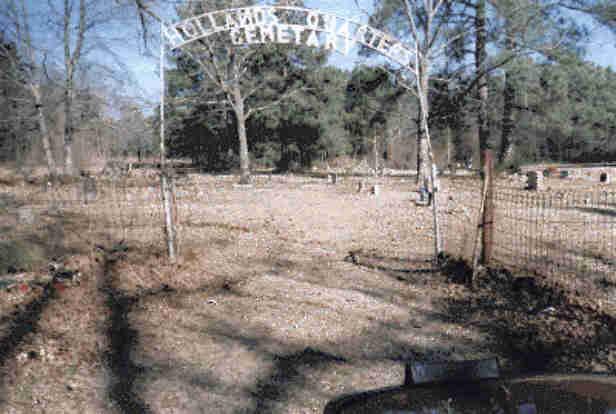History of the Holland Quarters Cemetery
3rd Edition Researched by Barbara Jefferson-BonnerEstablished December 1895
December 1895 / December 2000
 Holland Quarters Cemetery is located 5 miles west of Carthage, on US 79, 1 mile north on Farm-To-Market road (FM) 959 to County Road (CR) 277.
Holland Quarters Cemetery is located 5 miles west of Carthage, on US 79, 1 mile north on Farm-To-Market road (FM) 959 to County Road (CR) 277.
Over the years the cemetery has taken on names like: Baby Cemetery, Colored Cemetery, 5 Miles West Cemetery, Pine Grove Cemetery, Holland Quarters Cemetery and Holland Quarters Pine Grove Cemetery all referring to the same place (Holland Quarters Cemetery).
Unbroken Sacred Grounds
An infant, Baby Girl Rayson, was laid to rest in December of 1895, on new unbroken sacred grounds behind the community's second school (Holland High). The parents of this infant were William "Bud" Rayson and Betty "Bet" Holland.In 1911, Callie and Mamie Lou Rayson, two more children of William "Bud" Rayson and Betty "Bet" Holland were laid to rest on the same grounds where their older sister is resting.
Betty "Bet" Holland-Rayson had three children buried in what the neighborhood called the baby cemetery.
From that time forward Aunt Bet was known as the mother of the Cemetery.
On May 31, 1919 (grave-yard working day), Omie Rayson-Rowlett had worked most of the day when she sat down to nurse her young baby, Excella. Omie was hot and tired; she sat there a few minutes and all of a sudden she leaned over. The cry went out for help. When help arrived, there was nothing anyone could do. Omie was dead.
The Mother of the Cemetery, Betty "Bet" Holland-Rayson, died on September 6, 1919. She was laid to rest on the same grounds where her three daughters were buried.
The spelling of the 1956, overhead sign has never been corrected (HOLLANDS QUARTERS CEMETARY).
Headstones reveal misspelled names like KAYSON instead of Rayson and MANSON instead of Mason.
Prior to 1956, there was a trail beginning where the present overhead sign is, and ending at the corner of Ed Smith's land on FM 959. The first recorded burial on the left side of the new grounds for the cemetery was in March of 1956.
When William "Bud" Rayson died in 1956, he was returned to the "Quarters" for his final resting place.
These pages are in recognition of the families of Holland Quarters, dating from 1895 to 1998.
Keeping records in writing of cemeteries is most important for historical purposes, and for descendants of passed on relatives.
This information was obtained from the Holland Quarters Cemetery, Gregg County, Rusk County, and Panola County death certificates, newspapers, obituaries, family members, and family Bibles.
Before 1903, there were no official records on deaths. As family members died, they were laid out on a cooling board (flat piece of wood), in a separate room of their home.
Family members and friends would gather (the wake) to pay their last respects.
The deceased would be laid on the cooling board for 12 to 16 hours, depending on the time of day he/she died. In the meantime a family member was busy making a pine box (coffin). If the family member died before daybreak, he/she could be buried late that evening. If the family member died late in the day, he/she would lie on the cooling board until the next day. The ceremony began by placing the pine box (coffin) in the back of a wagon, and family members and friends would walk behind the wagon to the nearby burying place. Sometimes this took place in a wooded area near the home of the deceased.
At times, there were markers made with the departed's name, and dates of birth and death scratched on it, or a cross (two sticks crossed and tied with rope or vine). During this time, some deaths were recorded in family Bibles.
After 1903, rural communities still relied on the cooling board, and still did not record the death in the nearby county records office.
The information on the register of death sheets includes the names as written as they appears on the graves including the maiden name. The correct spelling is in quotation, date of birth, date of death, location of death certificate (book and volume), place of death, race, sex, and how the graves are identified.
The granite marked graves, cement marked graves, funeral marked graves, and unmarked graves are listed in numerical order by the year of death. Although graves that are listed in the Holland Quarters Cemetery, does not mean that the deceased died in Panola County. Death certificates are located in the county where the deceased died.
There may be other graves in the Holland Quarters Cemetery, but there are no markers, no obituaries, no record at the Panola County Clerk's Office, and no family members to show verification of the death and burial.
Descendants are still being buried in the HQ Cemetery.
Common Abbreviations: abt about, F funeral marker, M granite marker, U unmarked, no b/r no birth recorded, no d/r no death recorded, C concrete slab, obit obituary, dhs double headstone, s/s side by side headstone
See Panola County Historical Marker
On September 6, 1995, I submitted an application with narrative to the Texas Historical Marker Commission in Austin, Texas, for a marker for the Holland Quarters Cemetery marking the cemetery 100 years old. The application was approved on February 7, 1996, Job #00696.August 3, 1996, at 3:00 PM, the dedication for the Texas Historical Marker took place at Pine Grove Baptist Church, Theme: dress 100 years ago. The marker were places in a concrete monument by Chad Hicks, Ralph Hicks, Jr., Fred Graves, and myself (Barbara Bonner) researcher for the project. The monument were designed by me and constructed by Carthage businessman Ulysses Graves.

